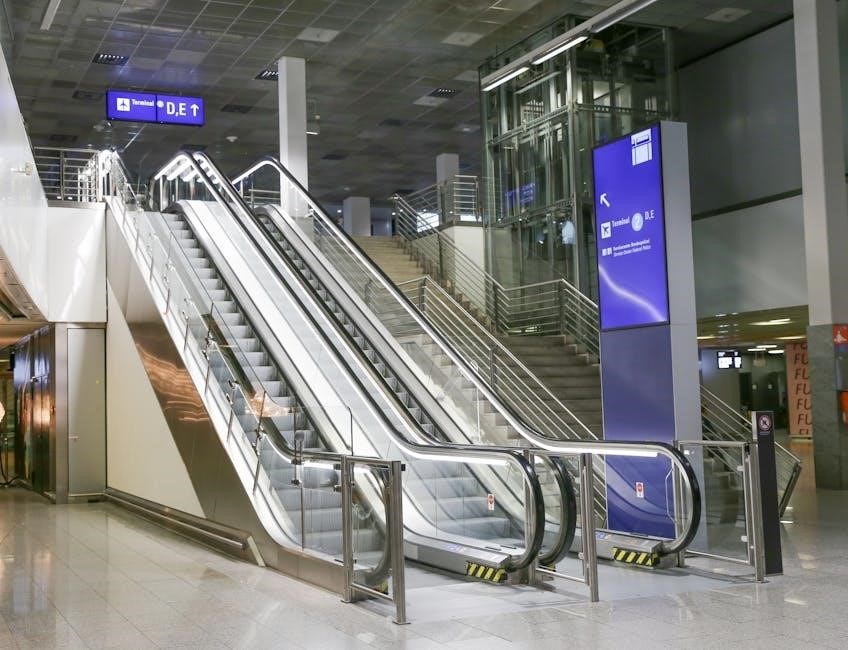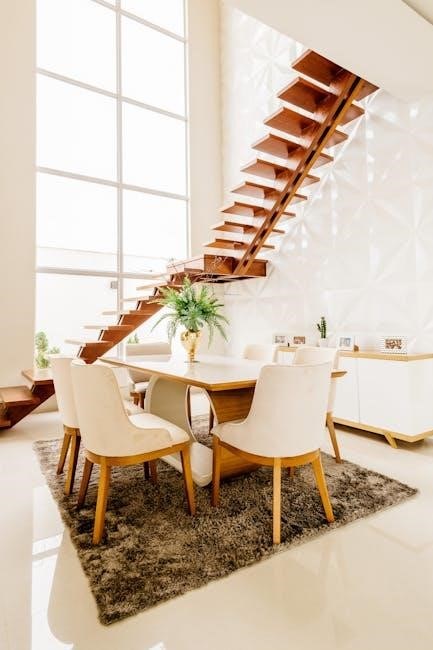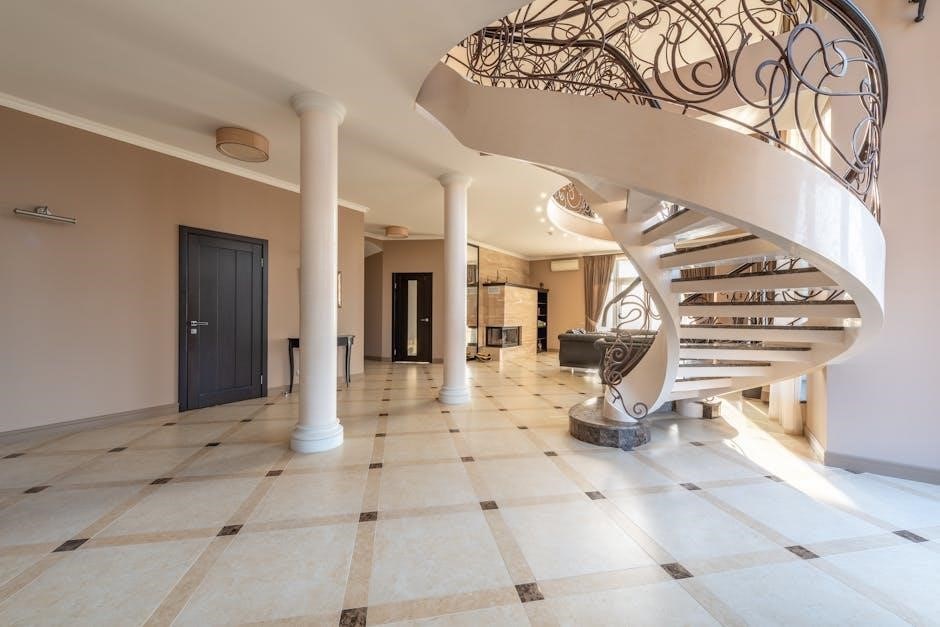This guide provides a comprehensive overview of stairs, focusing on their design, functionality, and safety․ Stairs are essential components in buildings, serving both functional and aesthetic purposes while ensuring user safety․
1․1 Overview of Stairs and Their Importance
Stairs are a fundamental component of buildings, serving as a means of vertical movement between floors․ They provide accessibility, functionality, and connectivity within structures, making them indispensable in both residential and commercial spaces․ Beyond their practical purpose, stairs also play a role in the aesthetic design of a building, often becoming a focal point in interior architecture․ Their importance extends to safety, as they offer a reliable means of evacuation during emergencies․ Additionally, stairs promote physical activity, contributing to health and well-being․ Understanding their design, construction, and maintenance is essential for ensuring they meet safety standards and user needs․ This guide explores the intricacies of stairs, from their basic structure to advanced design considerations, helping readers appreciate their significance and versatility in modern and traditional settings․
1․2 Why a Stair Guide is Necessary
A stair guide is essential for ensuring the safe and efficient design, construction, and maintenance of staircases․ Stairs are a critical component of buildings, yet their complexity often leads to errors in installation and upkeep․ A comprehensive guide helps users navigate the intricacies of stair systems, from selecting materials to adhering to building codes․ It serves as a valuable resource for homeowners, architects, and contractors, providing clear instructions and best practices․ Whether for new constructions or renovations, a stair guide ensures that staircases are functional, safe, and aesthetically pleasing․ By addressing common challenges and offering practical solutions, it empowers individuals to make informed decisions and avoid costly mistakes․ Ultimately, a stair guide is indispensable for creating durable, accessible, and visually appealing staircases that meet the needs of all users․

Design Considerations for Stairs
Effective stair design balances functionality, safety, and aesthetics․ Key factors include tread depth, riser height, and handrail placement․ A well-designed staircase enhances user experience and property value while ensuring durability and visual appeal․
2․1 Key Principles of Stair Design
Stair design revolves around safety, functionality, and aesthetics․ Proper tread depth, riser height, and handrail placement are critical for safe navigation․ Treads should be deep enough for comfortable foot placement, while risers must be consistent to prevent tripping; Handrails are essential for stability and accessibility, especially for the elderly or individuals with mobility challenges․ The design should also consider the overall purpose of the staircase—whether it’s for residential, commercial, or industrial use․ Aesthetic elements like materials, finishes, and lighting can enhance the visual appeal of the stairs․ Additionally, the staircase must comply with local building codes to ensure structural integrity and safety standards․ Balancing these elements ensures that stairs are both functional and visually pleasing, contributing to the overall design of a building while prioritizing user well-being and accessibility․
2․2 Types of Staircases: Spiral, Straight, and L-Shaped
Staircases come in various designs to suit different spaces and aesthetic preferences․ Spiral staircases are known for their sleek, space-saving design, featuring a circular path that connects floors․ They are often used in modern homes or commercial spaces for their visual appeal and efficiency․ Straight staircases are the most common type, offering a straightforward and practical solution․ They are ideal for residential and commercial settings where simplicity and accessibility are prioritized․ L-shaped staircases, also known as quarter-turn stairs, combine functionality and style․ They feature a 90-degree turn, making them suitable for both compact and open layouts․ Each type offers unique advantages, catering to various architectural needs while ensuring safety and accessibility․ The choice of staircase often depends on the available space, desired aesthetic, and functional requirements of the building․
2․3 Choosing the Right Materials for Stairs
Selecting the appropriate materials for stairs is crucial for durability, aesthetics, and safety․ Hardwood remains a popular choice due to its classic appeal and long lifespan․ Carpeted stairs offer noise reduction and cost-effectiveness, making them ideal for homes with heavy foot traffic․ Metal stairs are durable and versatile, suitable for modern designs․ Glass stairs provide a sleek, contemporary look but require careful maintenance․ Stone stairs, such as marble or granite, add luxury and durability but can be heavy and expensive․ Concrete stairs are highly customizable and strong, though they often need finishing․ Each material has its pros and cons, and the decision should consider factors like budget, maintenance, and desired style․ Additionally, combining materials, such as wood with metal railings, can enhance both functionality and visual appeal․ Proper material selection ensures that stairs are both functional and aesthetically pleasing for years to come․

Safety Features in Stair Construction
Safety is paramount in stair construction, involving handrails, proper tread depth, and riser height․ Building codes ensure structural integrity, while features like nosing and slip-resistant surfaces enhance user safety and prevent accidents․
3․1 Building Codes and Regulations for Stairs
Building codes and regulations are essential for ensuring stair safety and accessibility․ These guidelines dictate the maximum and minimum dimensions for risers, treads, and landings, ensuring uniformity and safety․ Compliance with local building codes is mandatory, as they are designed to prevent accidents and ensure that stairs are accessible to all users, including those with disabilities․ Key aspects include the allowable rise per step, tread depth, and the requirement for handrails․ Regular inspections and adherence to these codes help maintain the structural integrity and safety of staircases․ By following these regulations, architects and builders can create safe and functional stairways that meet legal and safety standards․
3․2 Importance of Handrails in Stair Safety
Handrails are a critical component of stair safety, providing essential support and balance for users․ They are particularly vital for the elderly, young children, and individuals with mobility challenges․ Handrails help prevent accidents by offering a secure grip, reducing the risk of falls and injuries․ Properly installed handrails should be continuous along the stair flight and landing, with a graspable shape and height that meets building codes․ They also serve as a guide for visually impaired individuals, enhancing accessibility․ Regular inspection and maintenance of handrails are necessary to ensure they remain sturdy and functional․ Compliance with local building codes ensures handrails are designed and installed to maximize safety and usability for all users․

Construction and Installation of Stairs
Stair construction involves precise planning, materials selection, and skilled craftsmanship to ensure safety and durability․ Proper installation requires adherence to building codes, accurate measurements, and a focus on creating a sturdy, functional structure․
4․1 Step-by-Step Guide to Building Stairs

Building stairs requires meticulous planning and execution to ensure safety and functionality․ Start by determining the total rise and run, adhering to local building codes․ Calculate the number of steps by dividing the total rise by the desired step height, typically 7-7․5 inches․ Next, cut the stringers, ensuring they are level and securely attached to the floor and landing․ Install the treads and risers, using screws or nails for stability․ Add supporting brackets or carriage bolts for added strength․ Finally, sand and finish the stairs with paint, stain, or carpet, ensuring a smooth and durable surface․ Always double-check measurements and consult professionals if unsure․
4․2 Tips for Proper Installation of Staircases
Proper installation of staircases is crucial for safety and durability․ Begin by ensuring the staircase design aligns with local building codes and regulations․ Use a laser level to confirm the stringers are perfectly aligned and level․ Secure the stringers to the floor and landing with anchor bolts or screws for stability․ When attaching treads and risers, pre-drill holes to avoid splitting the wood and use wood screws for a sturdy bond․ For carpeted stairs, stretch and staple the carpet tightly to prevent tripping hazards․ Handrails should be installed at the correct height and securely fastened to the wall or newel posts․ Regularly inspect and tighten all bolts and screws during the installation process․ Finally, sand all surfaces and apply a finish, such as stain or paint, to protect the wood and enhance the staircase’s appearance․ Proper installation ensures a safe and visually appealing staircase for years to come․
4․3 DIY vs․ Professional Installation: Pros and Cons
Deciding between DIY and professional staircase installation involves weighing several factors․ DIY installation can be cost-effective and allows for personal customization․ It suits those with experience in carpentry and access to tools․ However, it requires precise measurements and time, and errors can lead to safety hazards․ On the other hand, professional installation ensures compliance with building codes and high-quality craftsmanship․ Professionals handle complex designs and materials, minimizing the risk of structural issues․ While it may be more expensive, it offers long-term durability and safety․ For simple staircases, DIY can be manageable, but for intricate designs or large-scale projects, hiring a professional is advisable․ Ultimately, the choice depends on skill level, budget, and the project’s complexity․

Maintenance and Repair of Stairs
Regular maintenance ensures stair durability and safety․ Cleaning, inspections, and timely repairs prevent wear and tear, while addressing structural issues early avoids costly overhauls and enhances longevity․
5․1 Cleaning and Upkeep of Stairs
Regular cleaning and upkeep are essential to maintain the functionality and appearance of stairs․ Daily tasks include sweeping or vacuuming to remove dust, dirt, and debris, which can cause slipping hazards․ For harder surfaces like wood or tile, use a damp mop with a mild detergent to prevent damage․ Carpeted stairs should be vacuumed thoroughly, especially along the edges and corners where dust accumulates․ Deep cleaning, such as scrubbing or steam cleaning, may be necessary for stubborn stains or high-traffic areas․ Always test cleaning products on a small, inconspicuous area first to ensure they won’t damage the material․ Additionally, inspect and clean handrails and balusters regularly to maintain hygiene and safety․ Proper upkeep not only extends the lifespan of the stairs but also enhances their aesthetic appeal and ensures a safe environment for users․
5․2 Common Repairs for Damaged Stairs
Addressing damage to stairs promptly is crucial for safety and longevity․ Common repairs include fixing loose steps, which may involve tightening screws or replacing worn-out tread brackets․ Creaky stairs can be stabilized by adding wood shims or reinforcing joints with wood glue and clamps․ For carpeted stairs, loose carpeting should be re-stretched or re-tacked to prevent tripping hazards․ Damaged handrails or balusters may need to be replaced or refinished to restore structural integrity and aesthetics․ Cracks in concrete stairs can be repaired with epoxy or concrete patching compounds, while wood stairs might require sanding and refinishing to remove scratches or dents․ Regular inspections help identify issues early, preventing costly repairs․ Always use appropriate materials and techniques to ensure durability and safety․ If the damage is extensive or structural, consulting a professional is recommended to avoid further deterioration or potential accidents․
5․3 Regular Inspections for Safety
Regular inspections are vital to ensure stair safety and prevent potential hazards․ Start by examining the structural integrity of each component, such as treads, risers, and stringers, for signs of wear or damage․ Check handrails and balusters for stability and proper alignment, ensuring they meet local building codes․ Look for loose or uneven steps, which can cause tripping, and verify that all nails, screws, or bolts are securely fastened․ Inspect the condition of any carpeting or flooring for fraying or uneven edges․ Lighting is another critical aspect; ensure that stairs are well-lit, with functional handrail lighting if installed․ Pay attention to any corrosion or rot, especially in outdoor stairs, and address it promptly․ Document your findings and schedule repairs for any issues detected․ Regular maintenance not only enhances safety but also extends the lifespan of the stairs, providing peace of mind for users․

Enhancing the Aesthetic Appeal of Stairs
Enhance stair beauty with stylish lighting, such as LED strips under steps, and choose complementary colors or finishes․ Add decorative elements like newel posts or carpeting to elevate the design and comfort․
6․1 Lighting Ideas for Stairs
Effective stair lighting enhances both safety and aesthetics․ Consider installing LED strips under each step for a modern, ambient glow․ Recessed lighting in the ceiling or wall can create a sleek, minimalist look․ For a more traditional feel, use wall sconces or pendant lights to illuminate the staircase․ Solar-powered lights are an eco-friendly option for outdoor stairs․ Motion-sensor lights ensure energy efficiency by activating only when needed․ Adding under-step lighting not only improves visibility but also highlights architectural details․ Combining task lighting, like step lights, with ambient lighting ensures functionality while maintaining a stylish appearance․ Proper lighting design can transform stairs into a focal point of your home, blending safety with visual appeal․

6․2 Color and Finish Options for Stairs
Choosing the right color and finish for your stairs can significantly enhance their aesthetic appeal․ Neutral tones like beige, gray, and white are popular for their timeless look, while bold colors can add a statement piece to your home․ Wooden stairs can be stained to match existing decor, offering warmth and sophistication․ Painted finishes provide versatility, allowing you to customize the color to suit your interior design․ Metal stairs can be powder-coated in various hues for a modern, industrial vibe․ Carpeted stairs offer softness and noise reduction, with a wide range of textures and colors available․ Consider durability and maintenance when selecting finishes, as high-traffic areas may require more robust materials․ Balustrades and handrails can also be coordinated with the stair finish for a cohesive look․ Ultimately, the choice depends on your desired style, budget, and lifestyle․
6․3 Decorative Elements to Beautify Stairs
Stairs can be transformed into a focal point by incorporating decorative elements․ Lighting is a key enhancer, with options like LED strips under steps or sconces on walls adding ambiance․ Recessed lighting in risers or step edges creates a modern, sleek appearance․ Stair risers can feature decorative decals, tiles, or mirrors for visual interest․ Treads can be adorned with anti-slip strips in contrasting colors for both safety and style․ Carpeting offers warmth and noise reduction, available in various patterns and hues to match interiors․ Hardwood or metal stairs can have decorative nosing for edge protection and aesthetic appeal․ Balusters and newel posts in materials like wood, metal, or glass add elegance․ Wall decor, such as wallpaper or paneling, complements stair design․ Greenery, like plants or hanging vines, introduces natural beauty․ A statement chandelier above the stairs can elevate the space, making it a design centerpiece․ These elements harmonize functionality with style, enhancing your home’s beauty․

Inclusivity and Accessibility in Stair Design
Inclusive stair design ensures accessibility for all users, incorporating features like ramps, handrails, and tactile markings․ These elements promote safety and ease of use, making stairs accessible to everyone, including those with disabilities․
7․1 Incorporating Accessibility Features
Incorporating accessibility features into stair design is crucial for ensuring that stairs are usable by everyone, including individuals with disabilities․ Key elements include ramps or lifts for wheelchair access, handrails at appropriate heights, and tactile markings for visually impaired users․ Clear landings and adequate step dimensions also enhance safety and ease of use․
- Ramps and lifts provide alternative access for wheelchair users, ensuring compliance with accessibility standards․
- Handrails should be continuous and graspable, placed at a height of 34-38 inches to accommodate users of all ages and abilities․
- Tactile markings and contrasting colors help visually impaired individuals navigate stairs safely․
- Clear landings with minimal obstacles ensure easy movement and reduce tripping hazards․
- Step dimensions should follow guidelines, with riser heights between 4-7 inches and tread depths of at least 11 inches for secure footing․
These features promote inclusivity, making stairs accessible to everyone while maintaining aesthetic and functional design․
7․2 Making Stairs Child-Friendly
Designing stairs with children in mind involves prioritizing safety, comfort, and ease of use․ Child-friendly stairs incorporate features that minimize risks and accommodate smaller users․
- Soft materials like carpet or rubber surfaces reduce noise and provide better traction, preventing slips and cushioning falls․
- Lower riser heights and deeper treads make steps easier for little legs to navigate․
- Handrails at kid-friendly heights encourage proper grip and balance, teaching children to use handrails from a young age․
- Non-slip coatings or textured surfaces enhance safety, especially in high-traffic areas․
- Gates or barriers at the top and bottom of stairs prevent accidental falls and wandering․
- Visual guides, such as contrasting colors on risers, help children judge step heights more accurately․
- Rounded edges on handrails and steps reduce injury risks․
These thoughtful designs ensure stairs are safe and accessible for children while fostering independence and confidence․
This guide provides a comprehensive approach to stair design, safety, and functionality, ensuring balance between aesthetics and practicality․ Refer to additional resources for deeper insights into specific topics․

8․1 Final Thoughts on Stair Guide
8․2 Additional Resources for Further Reading
For further exploration, consider utilizing online resources such as Google’s advanced search techniques to find detailed guides on stair design and safety․ Websites like Fine Homebuilding and This Old House offer in-depth articles on staircase construction and maintenance․ Additionally, books such as The Staircase: History and Theories by John Templin provide historical and theoretical insights․ For safety standards, refer to the International Building Code (IBC)․ Online forums like Houzz and Reddit’s Home Improvement community can connect you with professionals and DIY enthusiasts․ Lastly, platforms like Udemy offer courses on stair design and construction for hands-on learning․ These resources collectively provide a wealth of knowledge to enhance your understanding and execution of stair-related projects․
